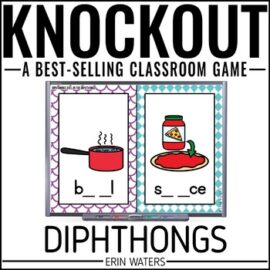March Madness, but make it elementary
We all know how fun the idea of a tournament is, and although I'm not a basketball fan, I love the idea of a good bracket. There's just something about the 50/50 nature of each step in the tournament when one team advances and the other does not. Of course, this is a bit cutthroat for the elementary crowd, which is why I decided to create a kid-friendly set-up for a classroom math tournament game:

Important: All of the materials I'm going to show you are are free and can be downloaded here.
Tip #1: Display charts or slides the whole class can see
Whenever possible, I like to keep things paperless. That usually means PowerPoint or other slides that I can project on the SmartBoard for all the students to see. This is usually the most efficient way of doing things in the classroom, and this is no exception. These are PowerPoint slides, so you can edit them directly in PowerPoint to reflect your classroom's information.
Tip #2: Pre-pick student teams
You have two options here: choose teams strategically ahead of time and announce them to students or choose them randomly with the students. If you have a lot of personality conflicts or a wide range of academic abilities, you might want to consider creating the teams ahead of time so that they are waited fairly and don’t result in a lot of behavioral disruptions. Otherwise and especially with older kids, it might be more exciting to choose teams randomly together as a group because it adds to the excitement and the atmosphere of the classroom math tournament game.
When you download the materials, you'll get a team name generator on a slide that looks like this:

Tip #3: Make a schedule
Once the tournament starts kids are going to get hooked really quickly on the game itself so it will pay off to make a schedule ahead of time. You can display the schedule with team names and the days of the week and morning or afternoon to signify when they can anticipate playing. If your students have already learned how to tell time this might be a great place to have pictures of clocks or digital times listed to enforce that skill.
Tip #4: Make sure to integrate SEL/sportsmanship
One of the most common questions I get about Knockout is how to make sure that students aren’t getting mad when they lose or pouting when they are knocked out. It certainly doesn’t happen overnight but if you can infuse some mini-lessons about sportsmanship and fair play and positive attitudes and being a good loser and so on. Every time you play, Knockout actually becomes a time of day where are your students' sportsmanship and kindness will flourish in the team setting.
You might even consider having a rotating list of topics that you can review quickly as a group before each set of Knockout games. Things like:
- What to do and say when your team wins
- What to do and say when your team loses
- Dos and don'ts for when you are knocked out
- Dos and don'ts for cheering on your teammates
- The characteristics of a good sport
- A general review of the rules of the game
Tip #5: Try it out with several games
You can definitely use this bracket set up for more math games beyond just knockout. However, if you are interested in looking into Knockout Learning for your own classroom, I’ve compiled an inventory that you can filter and sort by grade level or by subject to find the game that is just right for you and your students. (Hint: you can even sort by price to grab all of the free ones offered!)
Tip #6: Make it fun!
One of my students' favorite parts was choosing the team names. This was something we did often, so we came up with several systems for choosing. It was nice to have a go-to way of choosing when a team was stuck and couldn't agree or decide on a name. You'll find the slide below in the free download here, but it's worth noting that this pre-made system works wonders with an indecisive bunch!








 Arm you with high-quality tools: Sleep peacefully at night knowing you’re doing what’s best for your students.
Arm you with high-quality tools: Sleep peacefully at night knowing you’re doing what’s best for your students. Save your energy: Provide resources that cost you little energy (that stuff is precious)---but have high impact on your students.
Save your energy: Provide resources that cost you little energy (that stuff is precious)---but have high impact on your students. Light your spark: Putting fun back into your classroom after the hardest teaching years can be just what you and your students need.
Light your spark: Putting fun back into your classroom after the hardest teaching years can be just what you and your students need.
Leave a Comment